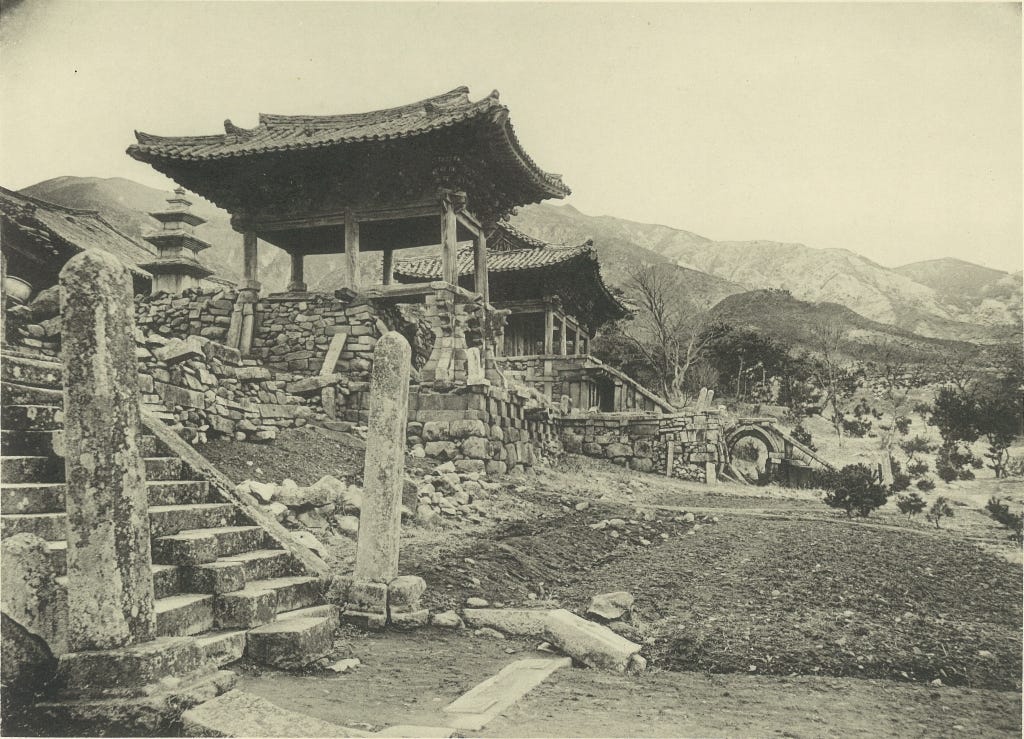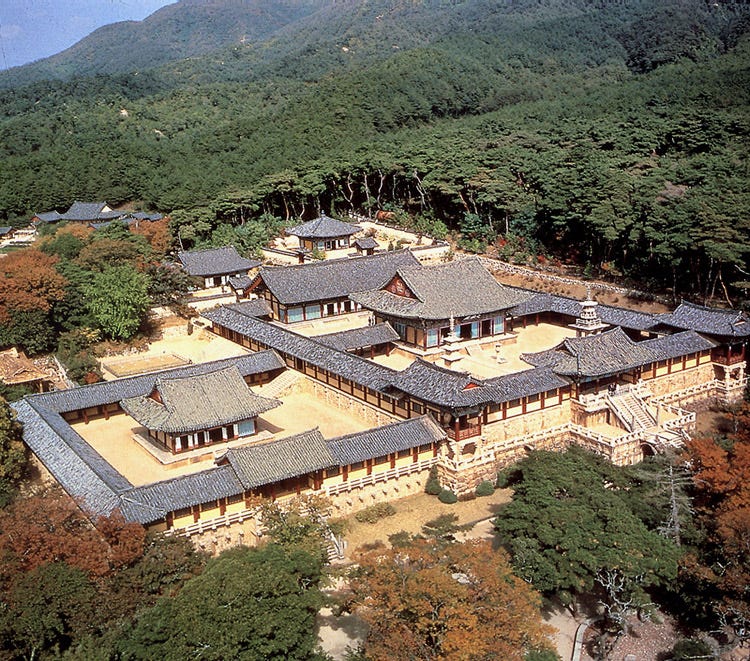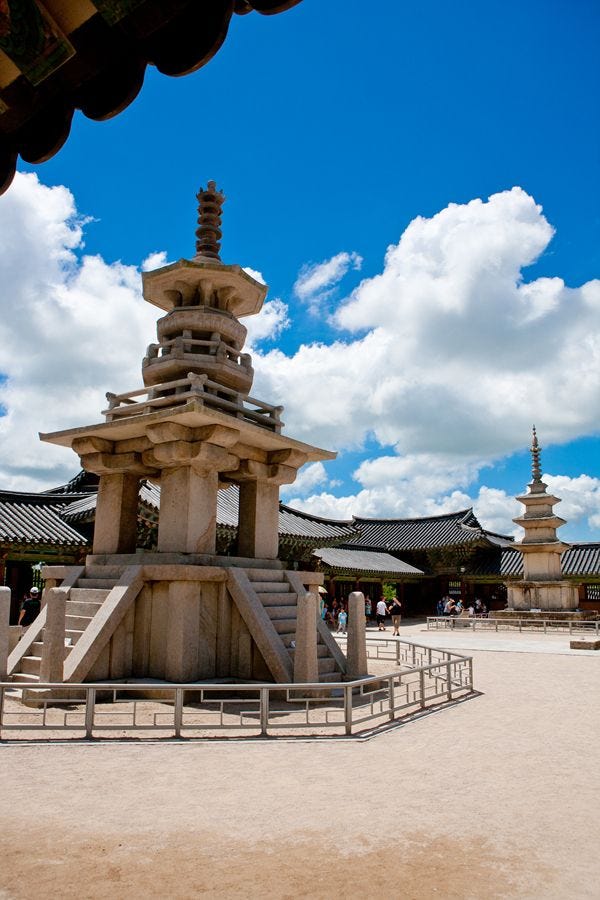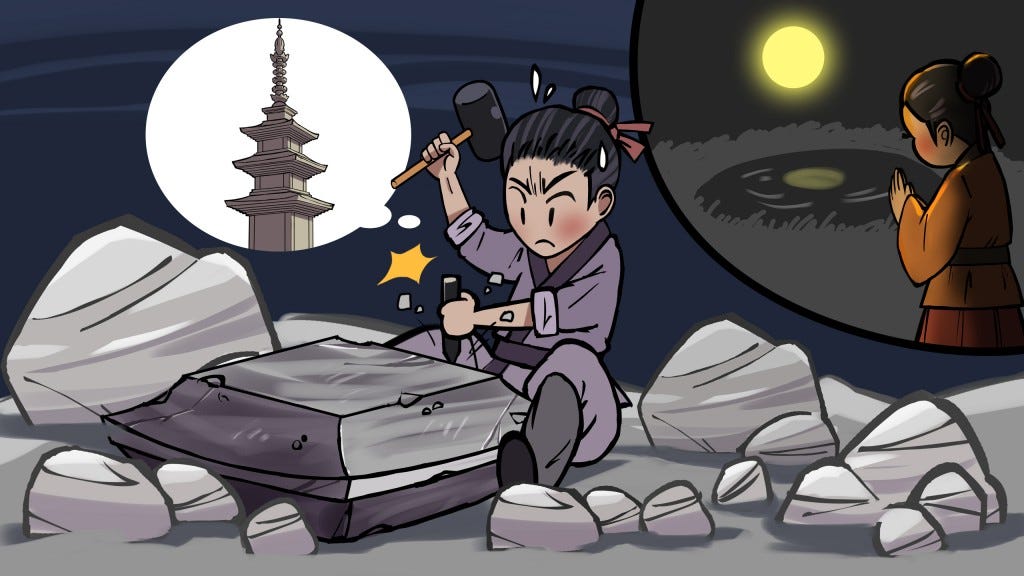Regardless of religion or creed, please pray for the firefighters and the people of Los Angeles—my home for the past 40 years. We’re okay so far, but things can change with one bad turn of the winds…
Very rarely, I get to kill two birds with one stone when it comes to writing about Korea. Last week, I left out the fourth and the final “opera” story in the K-drama Jeongnyeon because I felt that it deserved its own post. In this light, I will today talk about the story of Asadal (아사달) and Asanyeo (아사녀) to fill in the last blank for the K-drama and start the discussion on the city of Gyeongju (경주), an ancient capital city of Shilla dynasty that’s been called an “open-air museum.” Referring to the fact that the entire city is a treasure trove of historical artifacts—excavation still going on and probably for the next 100 years.

I’ve been to Gyeongju once, almost 30 years ago in 1996. I had lived in Korea for 3.5 years prior to that and wanted to visit the city before I came back to the US. It was more of a perfunctory visit—I felt kind of guilty never having been there as someone who likes reading about history.
That 2-night 3-day trip in unusually cold February was eye-opening, to say the least. One day I’ll talk about my most profound experience standing in front of the GREATEST artwork ever created (in my opinion, of course) that happened in Gyeongju, but today let’s focus on the most famous Buddhist temple in all of Korea—Bulguksa (불국사). Bulguksa written in Chinese is 佛國寺, “Buddhist Nation Temple,” telling us how important Buddhism was to the Shilla dynasty people.
This is the most frequently used shot of the famed temple—I found out why the temple’s photographs are almost exclusively taken from this angle when I actually stood on the grounds. There is not enough land in front of it to capture the entire facade of the entrance.
Originally thought to have been built in 574, it was expanded to its current form in 751 and rebuilt a few times over the centuries. I can write a 10-page paper on the temple alone, but let’s move on.
In the center court of the Bukguksa temple, there are two of the most famous pagodas in all of Korea—one is called Dabo-tahp (다보탑) and the other Seokga-tahp (석가탑), both of which are designated “National Treasures.”
Dabo-tahp is more ornate and has its own story, but we’ll look at the Seokga-tahp more closely today because it involves the story of Asadal and Asanyeo, as portrayed in the K-drama Jeongnyeon.
You know how the Egyptian pyramids of Giza are built so mathematically perfect that they’re still puzzling to the scientists and mathematicians of today? It’s built in (almost) perfect accordance to what’s called the Golden Ratio that repeats itself in nature over and over again, that gives an esthetically pleasing look and well-maintained balance. It is basically as same as the Fibonacci sequence also.
The math is whatever, but that 1.618 is the magic number to keep in mind.
Looking at our Seokga-tahp more closely, do you get the sense, at the first glance, that it just looks very well-proportioned and well-balanced? Not too sharp vertically and not too thin or flat horizontally.
Well, guess what else is built according to the Golden Ratio?
Each compartment of the tahp (탑, pagoda) is built in the almost exactly in that 1.618 ratio (the lone 0.618 is also a part of the Fibonacci sequence). The only one that’s off by 3.9% is the second level—the only level that has an artificial filling for support that has the thickness of 30mm. Without that filling, it would be the perfect 1.618 ratio.1
With that, let’s get to the story of Asadal and Asanyeo, the last “opera” story featured in the K-drama Jeongnyeon (refer to last week’s post). Now, remember, Bulguksa Temple is in Gyeongju, the ancient capital city of Shilla dynasty that was bitter rival of Baekje (백제) dynasty for centuries during the Three Kingdoms period (c. 1st ~ 7th century).
You see, Baekje from the very old times was known for its handcraftsmanship—whether it’s pottery, architecture, or stone masonry. So, when the Shilla royal court was building or expanding the Bulguksa temple, the head architect invited Asadal, a well-known stone mason in Baekje, to work on the most beautiful pagoda that anyone has seen.
While Asadal was working on the “math” and the actual construction of the pagoda, his wife Asanyeo, missing her husband who’s been gone for three years, traveled to Shilla to see him. But she was forbidden to enter the grounds of the temple—something about the female presence on the “holy” grounds being inauspicious.
One day, a Buddhist monk appeared before Asanyeo and told her to go wait by the nearby pond. When the pagoda is completed, you will see its shadow reflected on the waters, and when you do, you will be able to see your husband again.
So, Asanyeo waited by the pond every night, praying, but the shadow of the pagoda never appeared. Gravely distraught, Asanyeo threw herself into the pond and drowned to death. Soon after, Asadal finished his work on the Seokga-tahp and the same Buddhist monk told him that his wife had been waiting for him by the pond. Asadal ran but he couldn’t find her anywhere. After hearing of the tragedy, he started sculpting a likeness of her at the big rock nearby. He realized as he was working that the form of the sculpture was becoming that of the Buddha himself. Upon completion, he also threw himself into the pond.
Because the shadow of the pagoda was never cast on to the pond, Seokga-tahp has also come to be known as Moo-young tahp (무영탑, 無影塔), meaning “No Shadow” pagoda.
As romantic and Shakespearean tragic as this story is, it is NOT based on the real events. There is no mention of the name Asadal anywhere in written records—in fact, this is a plot of a novel written in the early 20th century called Moo-young Tahp and somehow the story has stuck. In the final episode of Jeongnyeon, an embellished version of this story is played out on the stage.

But, as a reference, I’ll point out the fact that there indeed is a pond named Young-ji (영지, Shadow Pond) near Bulguksa and there also is a worn sculpture of a Buddha on the edge of the pond.
I wanted to give proper credit to the professor who figured all this out, but the information is contained in a book written by Prof. Yoo Hong-joon, something in my possession but can’t find anywhere right now.













